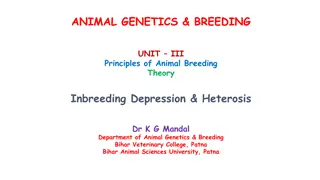Understanding Types of Heterosis and Predicting Performance of Double Cross Hybrids
Heterosis, also known as hybrid vigor, plays a crucial role in plant breeding. This article delves into different types of heterosis, including average, heterobeltiosis, economic, standard, and negative heterosis. It further discusses the prediction of performance in double cross hybrids involving four inbred parents. Various methods for predicting the performance of double cross hybrids are explored, offering valuable insights to enhance agricultural practices.
Download Presentation

Please find below an Image/Link to download the presentation.
The content on the website is provided AS IS for your information and personal use only. It may not be sold, licensed, or shared on other websites without obtaining consent from the author. Download presentation by click this link. If you encounter any issues during the download, it is possible that the publisher has removed the file from their server.
E N D
Presentation Transcript
PRACTICE SESSION TYPES OF HETEROSIS AND PREDICTION OF PERFORMANCE OF DOUBLE CROSS HYBRIDS
INTRODUCTION Heterosis :- It describes the phenomenon in which hybrids formed between individuals of the same or closely related species are more robust or vigorous than their parents. Thus, the terms Heterosis and hybrid vigor are often used interchangeably. Inbreeding Depression:- Cross pollinated species & species reproducing asexually are highly heterozygous. When these species are subjected to selfing or inbreeding they show severe reduction in vigourand fertility. This phenomenon is known as inbreeding depression.
TYPES OF HETEROSIS/ ESTIMATION OF HETEROSIS 1. Average heterosis or Relative heterosis: It is the heterosis where F1 is superior to mid parent value. In other words superior to average of two parents. F1 - MP Average heterosis= x 100 MP Where, F1= Mean of hybrid, MP = Mid parental value This type of heterosis is of no use in agriculture since the superiority is below the better parentvalue.
2.Heterobeltiosis: Superiority of f1 over the better parent. F1 - BP x 100 Heterobeltiosis = BP Where, BP = Mean of better parent 3.Economic or useful heterosis: Superiority of the F1 compared to the high yielding commercial variety in a particular crop. F1 - CV x 100 Economic heterosis = CV Where, CV = Mean of commercial variety
4. Standard heterosis: Sometime heterosis worked out Over the standard commercial hybrid. F1 - SH Standard heterosis = x 100 SH Where, SH = Mean value of standard (local commercial) hybrid 5. Negative heterosis: Performance of F1 inferior to better parent / mid parent value. e.g. Duration (earliness), height in cereals, micronaire value in cotton, and toxic substances like neurotoxin in Lathyrus sativus.
TYPES OF CROSSES Hybrid : First generation from a cross between two pure lines, inbreds, open-pollinated varieties, clones or other population that are genetically dissimilar Single cross : (A x B) Double cross : (A x B) x (C x D) Three way cross : (A x B) x Z Top cross : Inbred x open pollinated variety Polycross : Open pollination in isolation
PREDICTION OF PERFORMANCE OF DOUBLE CROSS HYBRIDS Aim- to know how to predict the performance of double cross hybrid In a double cross hybrid, four inbred parents are involved. The performance of a double cross hybrid can be predicted through any of the four methods indicated by Jenkins (1934). Starting with the simplest procedure taking four inbreds namely A, B, C and D, these methods are: 1. Top cross testing (one cross per inbred) to know the breeding value to each of the four inbred (total four top crosses per double cross i.e. Ax OPV, Bx OPV, Cx OPV and Dx OPV, where OPV= open pollinated variety).
2. Mean of the four non-parental single cross involved in (AxB) x (CxD) double cross viz. (AxC), (AxD), (BxC), and (BxD) (total 4 non parental single crosses per double cross). 3. Average yield performance of all possible six single crosses[n(n-1)/2] namely AxB, AxC, AxD, BxC, BxD and CxD (total six single crosses per double cross). 4. Average progeny performance of each inbred can be determined by the mean performance of each inbred in all possible single crosses of AxB, AxC and AxD will determine the average breeding value of the inbred A. Similarly, the mean of AxB, BxC, and BxD will indicate the potential of the inbred B and so on (total 12 crosses per double cross).
The available evidence shows that the method (b) i.e., mean performance of non-parental single crosses is the, most adequate and effective. Since there is a close correspondence between predicted and realized yields of double crosses in maize. Fortunately, the total number of crosses required to be sample per double cross is also the minimum, thus greatly the testing programme. All possible single crosses(in a Diallel mating)=n(n-1), Where n=number of inbred lines. All possible single crosses excluding reciprocal crosses = n(n- 1)/2 Total number of three way crosses=n(n-1)(n-2)/2 Total number of double cross =n(n-1)(n-2)(n-3)/8 Things to do: Problems on prediction of double cross hybrids performance























